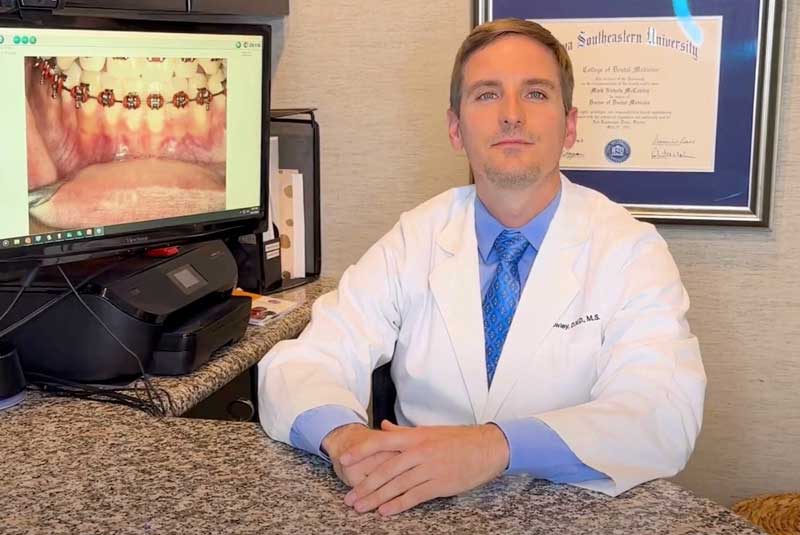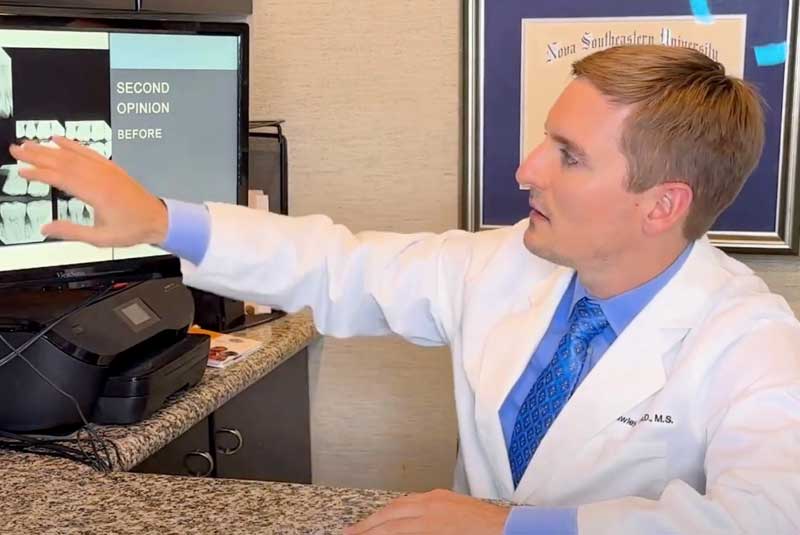Ridge Augmentation in Fort Lauderdale
When a tooth is lost, the bone that once supported it begins to shrink, a process known as alveolar ridge bone loss.
This happens because the jawbone is no longer stimulated by the tooth’s natural root. As the bone recedes, it can affect both the appearance of your smile and your ability to receive dental implants.
At the McCawley Center for Laser Periodontics and Implants, we use ridge augmentation to restore the height and width of the jaw after tooth loss or trauma. This bone graft procedure is often the first step toward rebuilding the solid foundation needed for long-term oral health and successful dental implants.
We offer sinus lift bone grafting at our periodontal clinic in Fort Lauderdale, FL.
What Is a Ridge Augmentation?
The alveolar ridge is the portion of the jawbone that holds the sockets for the roots of teeth. When natural teeth are present, the bony ridge is kept strong and active through everyday biting and chewing forces.
Once a tooth is lost either because of trauma, disease or tooth extraction, the ridge begins to shrink in that area because it no longer receives stimulation. Over time, this can lead to noticeable changes in the shape of your jaw and may compromise your ability to receive dental implants.
Ridge augmentation is a restorative bone graft procedure used to rebuild the alveolar ridge to its original height and width, restoring natural jaw contours and making implant placement possible again. In some cases, the entire shape of the ridge must be reestablished to support long-term function and achieve a natural appearance.
Learn more about dental bone grafts.
The alveolar ridge is the portion of the jawbone that holds the sockets for the roots of teeth. When natural teeth are present, the bony ridge is kept strong and active through everyday biting and chewing forces.
Once a tooth is lost either because of trauma, disease or tooth extraction, the ridge begins to shrink in that area because it no longer receives stimulation. Over time, this can lead to noticeable changes in the shape of your jaw and may compromise your ability to receive dental implants.
Ridge augmentation is a restorative bone graft procedure used to rebuild the alveolar ridge to its original height and width, restoring natural jaw contours and making implant placement possible again. In some cases, the entire shape of the ridge must be reestablished to support long-term function and achieve a natural appearance.
Learn more about dental bone grafts.
Why a Ridge Augmentation May Be Necessary
A ridge augmentation may be recommended when bone has already been lost due to a missing tooth, injury, or prolonged denture use. Without enough bone, placing a dental implant becomes difficult or unstable.
This dental procedure helps:
- Rebuild areas where the jawbone has shrunk or collapsed
- Restore natural contours for functional and aesthetic purposes
- Create a suitable foundation for dental implants
- Improve the long-term success of full-arch restorations
Cost of Ridge Augmentation
The cost of ridge augmentation varies depending on the extent of bone loss, the type of graft material used, and whether the procedure is combined with other treatments such as implant placement. At our practice, we provide a full treatment plan and review all costs during your initial consultation.
Ridge Augmentation Procedure Details
Every case begins with detailed imaging to assess the extent of bone loss. From there, we plan your treatment based on the unique structure of your jaw, using bone graft materials that encourage the body to rebuild what’s been lost.
The ridge augmentation procedure typically involves the following steps:
- Accessing the site: After sedative medication is administered, a small incision is made in the gum tissue to expose the area of bone loss. For patients who are anxious or undergoing multiple procedures, we also offer sedation options to help make the experience more comfortable.
- Preparing the site: The area is thoroughly cleaned and shaped to receive the graft. Any irregularities in the ridge are smoothed to help the graft material sit securely.
- Placing the graft: Bone graft material is positioned in and around the tooth socket.
- Stabilizing the graft: The graft is secured in place, often with a resorbable membrane or collagen barrier to protect it during early healing.
- Closing the site: The gum tissue is repositioned and sutured to cover the area, allowing healing to begin.
As healing progresses over the following months, your body gradually replaces the graft material with natural bone. This process restores the previous height and width of the ridge, creating a strong, stable foundation for future implant placement.
Ridge Augmentation Healing Stages
Healing after ridge augmentation happens in phases, and each stage plays a critical role in the success of the graft:
1. Initial healing (first 1–2 weeks): Swelling and mild discomfort are common as the soft tissues begin to close around the graft. Stitches may be removed during this time if non-resorbable.
2. Early bone integration (first 6–8 weeks): The body starts forming new bone around the graft. Patients should avoid pressure on the area to allow uninterrupted healing.
3. Bone maturation (3–6 months): Over time, the graft material is replaced by your own bone. This phase is critical for achieving the volume and density needed to support a dental implant.
4. Re-evaluation: Once the graft has fully integrated, we re-image the site to confirm readiness for implant placement.
Each patient heals at a slightly different pace, and we monitor progress through regular check-ins to ensure optimal outcomes.
Symptoms of a Failed Ridge Augmentation
While ridge augmentation is a safe and effective procedure when performed by an experienced specialist, complications are possible. Signs of a failed ridge augmentation may include:
- Persistent swelling or pain at the surgical site
- Graft exposure or gum tissue not healing properly over the graft
- Infection at or near the graft site
- Loose sutures or unexpected bleeding from the site
If you experience any of these symptoms, prompt evaluation is important. In many cases, timely intervention can resolve the issue and still allow for successful implant placement in the future.
FAQs About Ridge Augmentation
A bone graft is a broad term that refers to placing material to encourage new bone growth in areas where bone is lacking. Ridge augmentation is a specific type of bone graft procedure that rebuilds the shape and volume of the jawbone after it has collapsed, usually to make dental implants possible.
Once the graft successfully integrates and new bone forms, the results of ridge augmentation are typically permanent, especially if followed by implant placement, which helps preserve bone volume long term. However, poor oral hygiene or health conditions can still impact bone stability over time.
Most patients experience moderate discomfort in the first few days after surgery. Pain is generally well managed with over-the-counter or prescribed medication, and sedation options are available during the procedure for added comfort.
Schedule Your Consultation in Fort Lauderdale
Ridge augmentation can make dental implants possible for patients who have experienced bone loss and need to rebuild the jawbone before implant placement.
If you are considering dental implants and have been told you may not have enough bone, we encourage you to schedule a consultation with Dr. Mark McCawley. We will evaluate your needs and determine if a sinus lift is the right next step.
To book an appointment at our periodontal office in Fort Lauderdale, FL, call (954) 807-4829 or visit us at 800 East Broward Blvd #706, Fort Lauderdale, FL.






